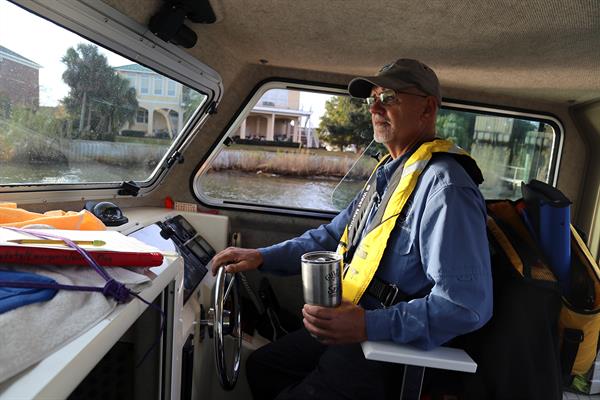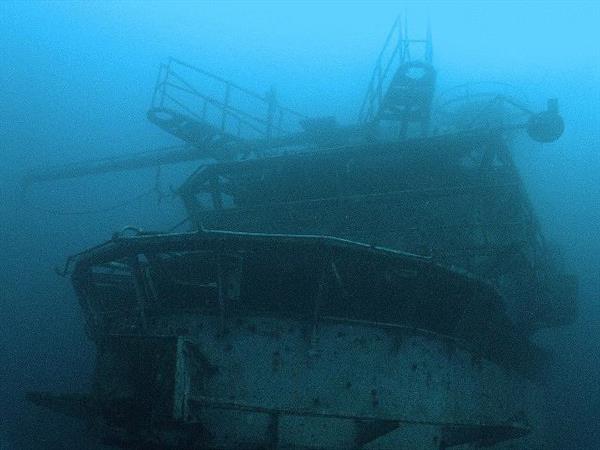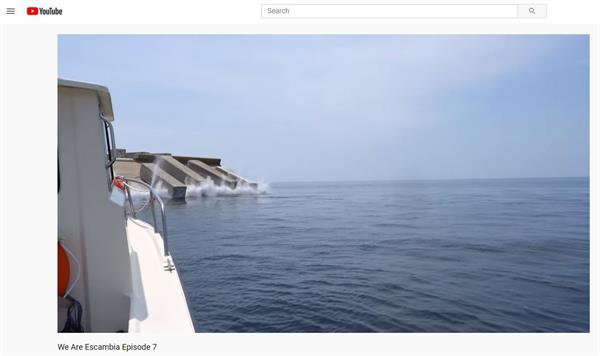
Search by Keyword
Search by Department
All Departments Administration Corrections Development Services Facilities Management Human Resources Information Technology Library Services Management and Budget Services Natural Resources Management Neighborhood and Human Services Parks and Recreation Public Safety Public Works Veterans Services Waste ServicesMiles of concrete sections from the Pensacola Bay Bridge have found a new life below the Gulf of Mexico’s surface as part of the Escambia South-East Artificial Reef Site.
Since October 2019, 75,000 tons of concrete bridge sections have been deployed into the Gulf to form eight new artificial reef sites. Each of the concrete sections weighs over 100 tons each and is deployed from a barge by Skanska USA Civil Southeast with the assistance of Escambia County Department of Natural Resources Management’s Marine Resources Division.
The 155th deployment took place on Monday, Aug. 17, strategically dropping 1,000 tons of concrete at the newest reef coordinates.
 A tug boat transports a barge carrying recycled bridge materials to the reef deployment site.
A tug boat transports a barge carrying recycled bridge materials to the reef deployment site.
Roughly 30 more deployments are planned through 2020.
The newly recycled reefs have been in the works since 2012, when the Florida Department of Transportation announced the replacement of the Pensacola Bay Bridge.
“Escambia County has a long history of recycling bridge materials and other materials for marine life habitat,” said Robert Turpin, Escambia County Marine Resources Division manager. “After FDOT announced the replacement project, I got to work immediately on planning for a permitted site that had the attributes we would need for a project of this size.”
The Marine Resources Division permitted an almost 9-square mile area inside state waters where state fishery law would apply and the reefs would be closer to Pensacola Pass.
"These new Pensacola Bay Bridge reefs are deployed less than nine nautical miles from shore, which reduces boat fuel expenses and allows anglers to harvest fish under state regulations—which are often less restrictive than federal regulations,” Turpin said, adding that the proximity of the reefs would also make them more accessible to smaller vessels, while remaining in deep enough water to attract marine life.

Captain Robert Turpin heads into the Gulf of Mexico to oversea an artificial reef deployment of recycled bridge materials.
The new reef site location is southeast of Pensacola pass, just east of the Russian freighter San Pablo.
“San Pablo was sunk after World War II and has been a fantastic artificial reef for many, many decades,” he said. “And that area of seafloor—I’ve been diving it since the mid-1970s—I knew that it was really good bottom. The seafloor has a lot of good organisms that live within it that serve as food for the reef.”
Turpin said a common misconception surrounding artificial reefs is the idea that after building a reef, you have to wait for algae to grow on the reef in order to attract fish. In fact, most of your game fish feed upon biological communities inside the sand sediment and in the plankton, and Turpin noted when a new reef is built in the Gulf, it’s almost immediately inhabited by snapper, grouper, triggerfish, amberjacks and many others.
 A young sea turtle and several fish swim near an artificial reef in Escambia County.
A young sea turtle and several fish swim near an artificial reef in Escambia County.
More than 530 public artificial reef sites are scattered throughout Gulf waters in Escambia County, providing a range of diving experiences and environmental benefits. The county-managed artificial reef program aims to create new marine habitats and boost economic development through tourism.
In addition to cultivating active and thriving ecosystems, the artificial reefs also draw divers from across the country.
According to a 2015 economic analysis conducted by UWF economist Dr. Bill Huth and funded by the Florida Fish and Wildlife Conservation Commission, the economic impact of fishing and diving on Escambia County artificial reefs is more than $150 million annually and supports more than 2,200 jobs.

USS Oriskany was sunk in 2006, 22 miles south of Pensacola in more than 200 feet of water.
In addition to the bridge materials, many reef sites are constructed using durable materials such as concrete prefabricated reefs, prefabricated reef modules, and steel barges and vessel materials.
Escambia County Department of Natural Resources Management’s Marine Resources Division is assisting Skanska USA Civil Southeast in the deployment of the reefs.
Deployments of recycled bridge materials take place several times a month, and more than 15 acres of artificial reef sites will be available to divers by 2021.
"These reefs provide a wonderful way to enjoy the natural resources of our beautiful area and experience the diverse wildlife and ecosystems of the Gulf of Mexico, " Turpin said.
Find a Reef
The Public Artificial Reef List also includes a link to a .gpx file, which allows users to upload the artificial reefs into their on-board GPS navigational equipment, something many newer GPS receivers include. The artificial reef coordinates are also provided in .kml format, allowing users to view Escambia County's public artificial reefs on the Google Earth platform.
View more information Escambia County artificial reefs sites, and a complete list of artificial reef coordinates here.
Reef Rules
1. Florida Law requires the use of the "Divers-Down Flag"
When divers are out of the water, a dive flag may not be displayed
CAUTION: Concrete may not be stable and diving/swimming under pieces of concrete could be hazardous to your health.
2. Snorkeling Reefs are not patrolled by lifeguards; snorkel at your own risk. Be aware of boat traffic, dangerous marine life, strong wave surge and currents, etc.
3. Always dive with a buddy--never dive alone!
4. Use a personal flotation device, snorkeling vest or other buoyancy aid.
5. Snorkelers and divers should adhere to beach warning flags.

Watch a video from the 155th reef deployment on Monday, Aug. 17.

The mission of Escambia County government is to provide efficient, responsive services that enhance our quality of life, meet common needs and promote a safe and healthy community.
Under Florida law, IP addresses and both the content of emails and email addresses are public records. If you do not want your IP address and the content of your email or your email address released in response to a public records request, do not send electronic mail to this entity. Instead, contact this office by phone or in person.

